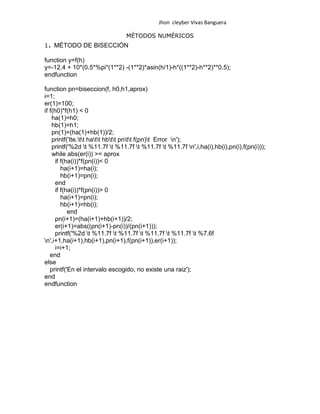
Metodos Numericos(Segundo Taller De Aplicadas)
- 1. Jhon cleyber Vivas Banguera MÉTODOS NUMÉRICOS 1. MÉTODO DE BISECCIÓN function y=f(h) y=-12.4 + 10*(0.5*%pi*(1**2) -(1**2)*asin(h/1)-h*((1**2)-h**2)**0.5); endfunction function pn=biseccion(f, h0,h1,aprox) i=1; er(1)=100; if f(h0)*f(h1) < 0 ha(1)=h0; hb(1)=h1; pn(1)=(ha(1)+hb(1))/2; printf('Ite.tt hatt hbtt pntt f(pn)t Error n'); printf('%2d t %11.7f t %11.7f t %11.7f t %11.7f n',i,ha(i),hb(i),pn(i),f(pn(i))); while abs(er(i)) >= aprox if f(ha(i))*f(pn(i))< 0 ha(i+1)=ha(i); hb(i+1)=pn(i); end if f(ha(i))*f(pn(i))> 0 ha(i+1)=pn(i); hb(i+1)=hb(i); end pn(i+1)=(ha(i+1)+hb(i+1))/2; er(i+1)=abs((pn(i+1)-pn(i))/(pn(i+1))); printf('%2d t %11.7f t %11.7f t %11.7f t %11.7f t %7.6f n',i+1,ha(i+1),hb(i+1),pn(i+1),f(pn(i+1)),er(i+1)); i=i+1; end else printf('En el intervalo escogido, no existe una raiz'); end endfunction
- 2. Jhon cleyber Vivas Banguera MÉTODOS NUMÉRICOS 2. MÉTODO DE NEWTON-RAPHSON function y=f(x) y=2*(x**3) + x- 1; endfunction function y=df(x) y=6*x**2 + 1; endfunction function pn=newtonraphson(f, p0,aprox ); i=1; er(1)=1; pn(1)=p0; while abs(er(i))>=aprox; pn(i+1)=pn(i)-f(pn(i))/df(pn(i)); er(i+1)=abs((pn(i+1)-pn(i))/pn(i+1)); i=i+1; end printf(' i t pn(i) Error aprox (i) n'); for j=1:i; printf('%2d t %11.7f t %7.6f n',j-1,pn(j),er(j)); end endfunction
- 3. Jhon cleyber Vivas Banguera MÉTODOS NUMÉRICOS 3. ITERACIÓN DE PUNTO FIJO function y=f(t) y=300-80.425*t+201.0625*(1-2.718281828**(-(0.1)*t/0.25)); endfunction function pn = puntofijo(f, p0,aprox) i=1; er(1)=1; pn(1)=p0; while abs(er(i))>=aprox; pn(i+1) = f(pn(i)); er(i+1) = abs((pn(i+1)-pn(i))/pn(i+1)); i=i+1; end printf(' i t pn(i) Error aprox (i) n'); for j=1:i; printf('%2d t %11.7f t %7.7f n',j-1,pn(j),er(j)); end endfunction
- 4. Jhon cleyber Vivas Banguera MÉTODOS NUMÉRICOS 4. a- EL MÉTODO DE NEWTON P0 = 1 function y=f(x) y=4*cos(x)-2.718281828**(x); endfunction function y=df(x) y=-4*sin(x)-2.718281828**(x); endfunction function pn=newtonraphson(p0,aprox); i=1; er(1)=1; pn(1)=p0; while abs(er(i))>=aprox; pn(i+1)=pn(i)-f(pn(i))/df(pn(i)); er(i+1)=abs((pn(i+1)-pn(i))/pn(i+1)); i=i+1; end printf(' i t Pn(i) Error aprox (i) n'); for j=1:i; printf('%2d t %11.7f t %7.15f n',j-1,pn(j),er(j)); end endfunction b) EL MÉTODO DE LA SECANTE function y=g(x) y=4*cos(x)-2.718281828**(x); endfunction function pn = secante(x0,x1,aprox) j=2; i=1; pn(1)=x0; pn(2)=x1; er(i)=1; while abs(er(i))>=aprox pn(j+1)=(pn(j-1)*f(pn(j))-pn(j)*f(pn(j-1)))/(f(pn(j))-f(pn(j-1))); er(i+1)=abs((pn(j+1)-pn(j))/pn(j+1)); j=j+1; i=i+1; end printf(' i tt pn(i) tt Error aprox (i) n'); printf('%2d t %11.7f tt n',0,pn(1)); for k=2:j; printf('%2d t %11.7f t %7.8f n',k,pn(k),er(k-1)); end endfunction
- 5. Jhon cleyber Vivas Banguera MÉTODOS NUMÉRICOS 5. a- Aplique el método de la secante function y=f(x) y=x**2-6; endfunction function pn = secante(f, p0,p1,aprox) j=2; i=1; pn(1)=p0; pn(2)=p1; er(i)=1; while abs(er(i))>=aprox pn(j+1)=(pn(j-1)*f(pn(j))-pn(j)*f(pn(j-1)))/(f(pn(j))-f(pn(j-1))); er(i+1)=abs((pn(j+1)-pn(j))/pn(j+1)); j=j+1; i=i+1; end printf(' i tt pn(i) t Error aprox (i) n'); printf('%2d t %11.7f t n',0,pn(1)); for k=2:j; printf('%2d t %11.7f t %7.7f n',k-1,pn(k),er(k-1)); end endfunction
- 6. Jhon cleyber Vivas Banguera MÉTODOS NUMÉRICOS b- Aplique el método de la falsa posición function y=f(x) y= (x^2) - 6; endfunction function xn=falsaposicion(f, a1,b1,max1) i=1; ea(1)=100; // xn vector que almacena la {xn} completa // ea error aproximado // i número de iteraciones realizadas // f función de iteración // a1 es el punto de partida o el intervalo a1 que luego se le asignara a x0 // b1 es el punto de partida o el intervalo a1 que luego se le asignara a x1 // max1 se utiliza para ajustar la exactitud de la aproximación if f(a1)*f(b1) < 0 x0(1)=a1; x1(1)=b1; xn(1)=x0(1)-f(x0(1))*(x1(1)-x0(1))/(f(x1(1))-f(x0(1))); printf('It.tt X0tt xntt X1t Error n'); printf('%2d t %11.7f t %11.7f t %11.7f n',i,x0(i),xn(i),x1(i)); while abs(ea(i))>=max1, if f(x0(i))*f(xn(i))< 0 x0(i+1)=x0(i); x1(i+1)=xn(i); end if f(x0(i))*f(xn(i))> 0 x0(1)=xn(i); x1(1)=x1(i); end xn(i+1)=x0(i+1)-f(x0(i+1))*(x1(i+1)-x0(i+1))/(f(x1(i+1))-f(x0(i+1))); ea(i+1)=abs((xn(i+1)-xn(i))/(xn(i+1))); printf('%2d t %11.7f t %11.7f t %11.7f t %7.7f n', i+1,x0(i+1),xn(i+1),x1(i+1),ea(i+1)); i=i+1; end else printf('No existe una raiz en ese intervalo'); end endfunction
- 7. Jhon cleyber Vivas Banguera MÉTODOS NUMÉRICOS c- La raíz de 6 = 2.449489742 Como podemos ver tanto por el método de la secante, como por el método de la falsa posición se obtiene un grado alto de aproximación a la raíz del numero 6; pero comparando cada expresión decimal producida por cada método, podemos determinar que el método que más se acerca es el de la secante.